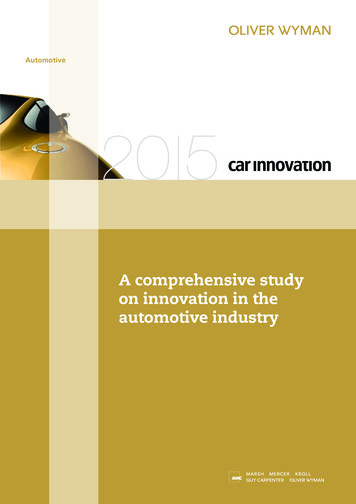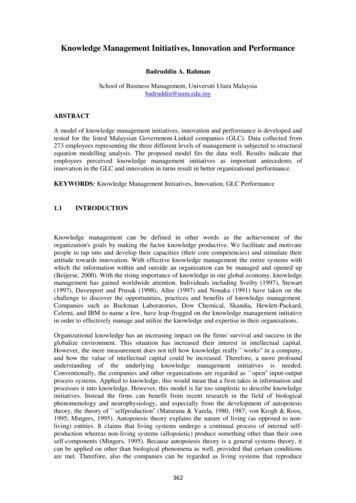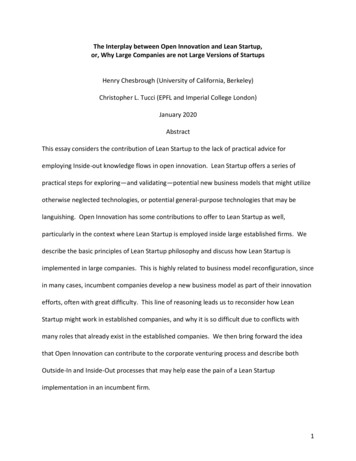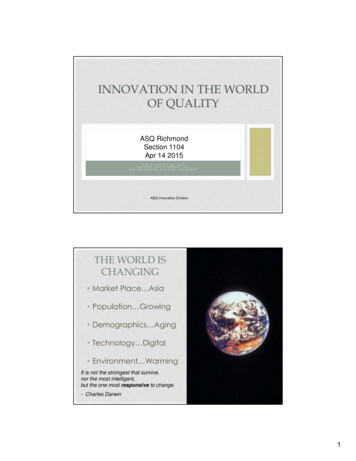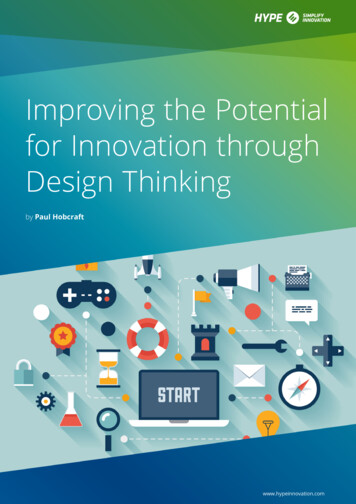
Transcription
Improving the Potentialfor Innovation throughDesign ThinkingHYPE Innovation Reportby Paul Hobcraft1www.hypeinnovation.com
IntroductionDesign Thinking (DT) evolved at many organizations as the way to solveproblems in creative and innovative ways. Much of the thinking behind theDT iterative process focuses on challenging assumptions and redefiningproblems for products, services or customer experiences.As Design Thinking has taken hold, there has been an increasing demand toraise up its capacity to help solving problems in our business complexities, inour countries and in our lives.We have been pushing Design Thinking to evolvethat it responds to the very different challenges thatare emerging, to apply this human-centred set oftechniques to solve increasing complexity acrossbroader problems and challenges.This means, we are entering a new period of raising the‘game’ of DT. Within this report, I lay down a foundationof Design Thinking as we see it today. Thus, the intent isto step back first, then take the step up to the presentand then where Design Thinking is heading. It shouldbe more strategic, as it shifts and adjusts to the needsCredits: Reality Check, GK Van Patter & ElizabethPastor, NextDesign Leadership Network, New York.of more complex challenges and problems wheretraditional approaches are now requiring this differentthinking perspective.2
A new scope within Design Thinking is raising the gamesignificantlyThe present difficulty isthat many of those whohave been trained inDesign Thinking a whileago didn’t adopt theirway of usage. Thus, theyapply older ways of DTthat lead to unsatisfyingresults. But we are facingdifferent challenges,recognizing the simpleones work well withdesign thinking but weneed to think differentlyin tools, skills, and DTapproaches for the morecomplex problems thatCredits: Reality Check, GK Van Patter & Elizabeth Pastor, NextDesign Leadership Network, New York.most organizations areneeding to tackle.Credits: Reality Check, GK Van Patter & Elizabeth Pastor, NextDesign Leadership Network, New York.3
What is Design Thinking?How broad would you define design? We found it in product design, industrial design, designsystems and graphic design. McKinsey’s Jennifer Kilian offered this for DT:“Design Thinking is a methodology that we use to solve complex problems, and it is a wayof using systemic reasoning and intuition to explore ideal future state. We do this with theend user or the customer in mind, first and foremost.”With the view of McKinsey, they go on “As a broad term, it could mean such different things for different disciplines, fromindustrial design to experience design to digital design. It is increasing in importance aswe are seeing the limitation of traditional ways of approaching problems.”In this opening summary, I quote Tim Brown, the CEO of IDEO, one of the early pioneers ofestablishing Design Thinking as we know it today.“Design Thinking is a humancentred approach to innovationthat draws from the designer'stoolkit to integrate the needsof people, the possibilities oftechnology, and the requirementsfor business success.”Tim Brown,CEO OF IDEOExploring the current status of Design ThinkingI am not reinventing the wheel here but I took a “walk” around several useful references and greatexplanations and tried to synthesize them along with some of my own observations.4
I found great articles produced by Rikke Dam & Teo Siang, they wrote extensively about DesignThinking on behalf of the Interaction Design Foundation. Rikke & Teo and the rest of the teamare doing a great job by reviewing much within the current practice of Design Thinking, whereforeI asked Rikke if I could reproduce the parts. She agreed with the citations and references that sheclearly deserves.They work with the Interaction Design Foundation and many further good organizationsare shown below in the references/resource section at the end of this e-Book. They are anindependent non-profit initiative, established in Denmark with an objective to democratizelearning to create low-cost, high-quality education to change the way people learn design byproviding top-notch curricular materials, and aim to strike the perfect balance between academicrigor and practical relevance.Is Design Thinking on everyone's agenda?Well, it is getting there. The argument is that Design Thinking meets a need. With newgenerations of designers who are trained to blend technology and business, they became moreagile in moving across different spheres and connecting more of the dots. There are broaderconversations. Design Thinking helps to break down siloed thinking into more ‘integrated’conversations.Design Thinking becomes more central to business strategies, marketing strategies and execution,works in operations and product design and helps to tackle social problems. So, it is becomingfar more important than in the past. Furthermore, experience design can be a real sourceof competitive advantage, as the meeting point where a company wants to be and creatingsolutions that improve on getting there to achieve customer needs far more in ‘their’ ways ofunderstanding.You can increasingly recognize that we live in a constraint-limited environment. What we do needsa fundamental rethink and design. We spend our Design Thinking pushing downstream1 but theexpectations need to change as the challenges become more complex to tackle. Leaders arepushing Design Thinking to be part of this complex solving. Can Design Thinking move beyondits approach to products, services and experiences, and become far more upstream?11 Methodology terms originally coined by GK VanPatter & Elizabeth Pastor, CoFounders, Humantific, Authors: Innovation Methods Mapping, De-Mystifying 80 Years of Innovation Process Design.5
Overview: Rikke Dam AndTeo Siang Pieces Design Thinking starts with empathy, a deep human focus to gain insights which mayreveal new and unexplored ways of seeing, and courses of action to follow in bringing aboutpreferred situations for business and society. It involves reframing the perceived problem or challenge at hand, and gainingperspectives, which allow a more holistic look at the path towards these preferred situations. It encourages collaborative, multi-disciplinary teamwork to leverage the skills,personalities and thinking styles of many in order to solve multifaceted problems. It initially employs divergent styles of thinking to explore as many possibilities, deferringjudgment and creating an open ideation space to allow for the maximum number of ideasand points of view to surface. It later employs convergent styles of thinking to isolate potential solution streams,combining and refining insights and more mature ideas, which pave a path forward. It engages in early exploration of selected ideas, rapidly modelling potential solutions toencourage learning while doing, and allow for gaining additional insights into the viability ofsolutions before too much time or money has been spent It tests the prototypes which survive the processes further to remove any potential issues. It iterates through the various stages, revisiting empathetic frames of mind and thenredefining the challenge as new knowledge and insight is gained along the way. It starts off chaotic and cloudy steamrolling towards points of clarity until a desirable,feasible and viable solution emerges.6
Which problems can Design Thinking help us solve?One of the first questions people ask when hearing about Design Thinking is,"What is Design Thinking best used for?". Design Thinking is suited to address awide range of challenges and is best used for bringing about innovation withinthe following contexts: Redefining value Human-centred innovation Quality of life Problems affecting diverse groups of people Involving multiple systems Shifting markets and behaviours Coping with rapid social or market changes Issues relating to corporate culture Issues relating to new technology Re-inventing business models Addressing rapid changes in society Complex unsolved societal challenges Scenarios involving multidisciplinary teams Entrepreneurial initiatives Educational advances Medical breakthroughs Inspiration is needed Problems that data can't solveA holistic approach to challengesDesign Thinking is best suited to addressing problems where multiple spheres collide, at theintersection of business and society, logic and emotion, rational and creative, human needs andeconomic demands and between systems and individuals. We would most likely not requireDesign Thinking to tackle tame problems - problems that are simple and that have fixed andknown solutions - unless we were seeking a novel or innovative means to solving the problemwith a different desired goal than the typical available solutions.7
It's NOT just a process or set of stepsHowever, Design Thinking is not necessarily only understood as a process or method for solvinga set-in-stone collection of problems. It is also a mindset that can be applied in almost anyscenario where innovation or thinking differently is required. It can also be combined with othermethodologies, business strategies, social innovation models, and management practices. It'ssomething that changes depending on its context and can include tools and techniques fromother disciplines.One of the biggest issues: we need to resolve ingrainedpattern thinkingAuthors at the Interaction Design Foundation offered this to ponder. Sometimes, the easiest wayto understand something intangible, such as Design Thinking, is by understanding what it is not.Humans naturally develop patterns of thinking modelled on the repetitive activities andcommonly accessed knowledge. These assist us in quickly applying the same actions andknowledge in similar or familiar situations, but they also have the potential to prevent us fromquickly and easily accessing or developing new ways of seeing, understanding, and solvingproblems.These patterns of thinking are often referred to as schemas, which are organised sets ofinformation and relationships between things, actions, and thoughts that are stimulated andinitiated in the human mind when we encounter some environmental stimuli. A single schemacan contain a vast amount of information.For example, we have a schema for dogs which encompasses the presence of four legs, fur, sharpteeth, a tail, paws, and several other perceptible characteristics. When the environmental stimulimatch this schema — even when there is a tenuous link or only a few of the characteristics arepresent — the same pattern of thought is brought into the mind.As these schemas are stimulated automatically, this can obstruct a more fitting impression of thesituation or prevent us from seeing a problem in a way that will enable a new problem-solvingstrategy. Innovative problem solving is also known as “thinking outside of the box”.The real push is on getting maximum value out of Design Thinking.8
It's about human-centred innovationDesign Thinking works best when it comes to creating the human sense of things and tacklingchallenges in a way that best meets human needs, regardless of the scope and authority of thechallenge. A conformist, controlled, technical or linear approach is no longer able to grapple withthe newly complex and sensitive needs of modern society.It starts with an intention, a desire, a need or yearning towards a better situation or state. Wedon’t know whether this is a mere dream or a practical and viable path to take, but DesignThinking gives us the tools to explore What Could Be.9
Popular DT FrameworksHeart, Head and HandThe Design Thinking process is a blend of Heart, Head, and Hand. This means the process is basedon vision, need, emotion and feeling to begin with, continuing on to the cognitive processing forideation and evaluation and then diving into the practical creation by hand. It's a holistic processand demands input from all faculties to be successful.d.school’s 5 Stage ProcessAuthor/Copyright holder: Teo Yu Siang and Interaction Design Foundation. Copyright terms and licence:CC BY-NC-SA 3.0The Stanford Design School (d.school), now known as the Hasso Plattner Institute of Design, beganteaching a Design Thinking process with the following 3 steps: Understand Improve Apply10
Since then, they moved on to formulate and open source their famous 5 stage process whichis widely used. The d.school represents the 5 stage process by their hexagonal Design ThinkingLenses. The lenses are purposely defined so they will be seen more as enablers or modes ofthinking, rather than concrete linear steps.Deep-DiveThe Deep-Dive was IDEO'S first expression of this process, which they aired LIVE on ABC Nightlineback in the late 90's. Deep-Dive process comprises of the following steps: Understand Observe Visualise Evaluate ImplementDeloitte acquired the Deep-Dive process in 2006.IDEO's best known Design Thinking ProcessIDEO uses a different process, and while it has only three stages, covers pretty much the sameground as the other processes covered here. The three stages are: Inspire: The problem or opportunity that motivates the search for solution Ideate: The process of generating ideas Implement: The path that leads from the project room to the marketAlso, IDEO released a deck of IDEO Method Cards covering the modes Learn, Look, Ask, Try,each with their own collection of methods for an entire innovation cycle.HCD - Human-Centred DesignFurthermore, IDEO developed contextualised toolkits which repackaged the Design Thinkingprocesses. One such iteration focuses on the social innovation setting in developing countries.For this context, the terminology needed to be simplified, made memorable and restructured forthe typical kinds of challenges faced. The HCD process (Human-Centred Design) wasre-interpreted as an acronym to mean Hear, Create, Deliver.11
H: HearSimilar to early phases in other Design Thinking processes, the Hear stage is about developing anempathic understanding of users, as well as defining the problem that the team is trying to solve.It serves the purpose of gaining a solid foundation in the context of the problem and sufficientlyreframing it to progress. In this phase of the process, design thinkers need to: identify their challenge, recognise existing knowledge in the challenge space, identify people to engage with to understand the deeper human side of the challenge, engage in a range of ethnographic research activities to uncover sufficient human insight, and develop points of view or stories to guide the creation phase.C: CreateSimilar to the Ideate and Prototype phases in d.school’s 5-stage approach, the Create stageis concerned with exploration, experimentation and learning through making. It involvespinpointing potential areas of exploration, and then engaging those closest to the problem to cocreate solutions. This allows design teams to maintain the highest levels of empathy during earlydesign phases, as well as weed out potential problematic assumptions made by designers who donot sufficiently understand the context. Highlight opportunities to explore from insights gained in the Hear phase Recruit participants for the co-design task from a diverse pool of those affected Maintain awareness of sensitivities by avoiding judgements Encouraging storytelling and expression Facilitate action orientated creation of tangible solutionD: DeliverThe Deliver phase of the HCD process is centred around logistical implementation, andovercoming any obstacles which may exist when rolling out a solution within the requiredcontext. Though solutions arrived at may provide a functional patch to a problem, getting by incommunities and bypassing any other roadblocks on the path of implementation is essential forthe process to be completed successfully.12
Design Council of the UK: 4 D'sThe Design Council of the UK has settled on 4 D's: Discover, Define, Develop, Deliver. They makeuse of a Double Diamond process diagram to indicate 2 cycles of divergent and convergentthinking and activities.Frog DesignFrog Design's 3 D's Discover, Design, Deliver has been replaced with Explore, Converg andSupport, indicating a focus on more than just finite projects or products, but an ongoingrelationship with their clients well after delivery date.The LUMA SystemThe LUMA Institute, a global firm that teaches innovation and human-centred design, has its ownexpression of Design Thinking modes: Looking, Understanding and Making. This unfolds througha series of steps per mode completed with a proprietary user manual and method cards. Themodes allow for remixing a wide range of processes through the 3 modes using methods specificto your needs.13
Design Thinking Is Evolving As aStrategy 'Assist' for InnovationHow do you create a strategy for guaranteeing that innovation and creativity flourish in yourorganization?Design thinking has evolved beyond making objects. Organizations are pushing hard to getDT instilled in many parts of their business. They want their people to think like designersand understand how to apply the basics of design principles. It provides a unique edge tounderstanding problems, challenges and issues, a powerful competitive edge. Increasingly, thedesign way of thinking can be applied to solutions for procedures, system resolution, customerand user experiences. It moves from finding desirable solutions for products, services, andexperiences - it is pushing into contributing to solve more complex problems.The growing appeal of Design Thinking comes from its capability of combining imagination andintuition, by applying a certain logic and a systemic reasoning to explore possibilities. Possibilitiesof what could be and what is coming closer to the point of providing desired outcomes thatenhance, solve or benefit organizations and end users.14
Divergent and convergent processDesign Thinking employs divergent thinking as a way to ensure that many possible solutions areexplored in the first instance, and then convergent thinking as a way to narrow these down to afinal solution. Divergent thinking is the ability to offer different, unique or variant ideas adherentto one theme, while convergent thinking is the ability to find and realize the best idea/solution tothe given problem.Larry Keeley 's view on Design ThinkingLarry is a Director of the Deloitte Consulting LLP and President and Co-Founder of its innovationpractice, Doblin. He is a strategist who worked over three decades to develop more effectiveinnovation methods. As a globally recognized teacher, speaker, writer, and thinker, he ferventlychampions the strategic combination of design and business.His book, Ten Types of Innovation, The Discipline of Building Breakthroughs, codifies much ofthe research and tradecraft that drives effective innovation.In a piece written for Deloitte, called “Beyond Design Thinking”, he commented about ”The trendin a nutshell”:“Design Thinking” has been increasingly embraced by the world of business and businesseducation over the last decade. During a time of intense change, this is a positivedevelopment. It helps firms develop the courage and use tradecraft that moves beyondanalysis to embrace synthesis as well. This is part of what it takes to help firms commit tobuilding something bold and newsworthy, instead of only seeking the tactics needed tobetter sell what is already known.What many people are missing. Too often advocates of “design” overreach, regarding it as anelixir that can somehow transform conservative companies into creative ones. In the mostegregious cases, advocates suggest Design Thinking can somehow replace nearly all otherforms of analysis, planning, and strategy.What great leaders should know and do now. The power of design is real and increasinglyimportant. It can help firms build breakthroughs and change industries, but it has to bebalanced and integrated with other skills and capabilities. This is especially true now because15
there is a parallel revolution in how to get new insights from analytic techniques—and no oneshould ever jump right into innovating without first producing some set of profound insightsthat can be the basis for an innovation team to do the hard work of building a breakthrough.Put simply, analysis without synthesis is predictable and commonplace. Design Thinkingwithout deep analysis is reckless. The savvy leader now seeks to do both, recursively, inintegrated, even dazzling new ways.”Last year the Design Management Institute rigorously selected 15 design-centric publiclytraded companies. Those that made the cut include Apple, Coca-Cola, Ford, IBM, Intuit, Procter& Gamble, Starbucks, Nike, and others. These companies, which use design strategically andintegrate it through their business processes, tend to grow faster and have higher margins thantheir competitors - the identified companies’ returns were 2.28 times larger than the S&P’sreturns over the previous decade.Take away from Rikke Dam and Teo Siang“We could spend weeks exploring the Design Thinking Processes, their differences andsimilarities and the merits of variety or conformity. It is important for us to peel away thefacade to understand the foundations. To the first timer, at first sight, the Design Thinkingprocess is mysterious, chaotic, and at many times complex. However, it's a discipline, whichwill grow on you with direct practice. You will learn things in a practical manner, which notheory can adequately cover growing in confidence with each new experience. You may evenbe tempted to develop your own expression of these steps, modes, and phases to suite acompletely new context, and that's part of the beauty of Design Thinking.”The critical thing is to be ready to engage in all of the five stages:16
A pause here.Let's do some visual feastingBecause there are so many frameworks for Design Thinking, I clustered and rated some of myfavourite ones. By searching Google Images under “Design Thinking” you will find many more.17
18
19
20
Summary: Where Are We Today?I have the feeling that Design Thinking is currently a ‘burning platform’ and we are sufferingfrom the term ‘Design Thinking’ as it is so loaded. We are seeing it as a solution to all creativeproblems and often messy to understand. It has raised a lot of expectations as well as its fairshare of controversy with a fair share of failure when it was not achieving what was expected.I got the impression that there is an immense interest in DT as being a valuable contributor,and part of a solution within organizations to tackle their tougher problems, as well as thosethat need a level of creativity to move through in understanding.So why are organizations so caught by DT? Often it became the promise of having creative waysto solve solutions and work in harmony with all the rational thinking that dominates much ofbusiness thinking today. DT sounded so appealing, it quickly became “oh, we need some ofthat.” But the question then becomes “some of what?”21
Where Design Thinking Can EarnIts PlaceDesign Thinking can make real contribution through a good understanding and analysis of theusers, their problems, and challenges they are facing, by making use of ambiguous information,reframing opportunities, exploring ecosystem conceptualization, investing in prototyping tofail early and synthesizing the results as better outcomes. All this adds up to a creative process.Creativity is one of the key essences contributing to innovation, and Design Thinking is hugelyvaluable to harness this creative energy.Much of DT is working in a parallel space with many different paths to work through broadphases of investigative work. This makes DT seems “fuzzy, ambiguous and strange” to manywho are more trained in being analytical, often with backgrounds in science and engineering. Itis bringing a degree of art and creativity to science and rational thinking. This combination mustconstantly search for a common language to get the best out of a diverse group of thinkers, alltrying to find solutions.Design Thinking: the best friend of innovation,strategically and tacticallyWhen DT is applied to business or social issues, it is by making ‘creativity logical’. You have itspower of contribution. It can transform our innovative solutions. Design Thinking is a highlycreative problem-solving approach with a toolkit of methods, but more a specific mindset whereadapting is constant. If the same process gets repeated too often, it may bring only the sameresults or dampens the potential to spark different ideas and solutions. Design Thinking assomething far too prescribed ‘dulls’ the process. Design Thinking needs creativity within itself,bringing different framing concepts to different stages of the thinking through process.Danger: trying to “systematize” DT into a familiar, easy touse processOrganizations turned Design Thinking into a linear, often gated, by-the-book methodology andsuddenly it is not true Design Thinking anymore, it becomes just another too linear, slow andnot as bright way to be ‘so creative’. But hey, we are design thinkers, that’s not bad, is it? Thedominating thinking about ‘process’ starts to ‘screw up the freedom’ of true Design Thinking.22
It quickly became boiled down to aiding and supporting the incremental innovation. It loses itsreal powerful edge of harnessing creativity to solve problems in highly imaginative and insightfulways, it becomes just the encouragement to help thinking along.Design Thinking often gets reduced down to supporting small project-related work, happily beingused at the periphery of the organization. It becomes simply a friend to incremental innovationand change. Leaders start to ask questions about all this Design Thinking ‘hype’ and begindemanding far more from a Design Thinking process to tackle their complex problems.We need a different pathway ahead, otherwise theexisting form of DT will failDesign Thinkers should restate their value proposition before it is too late, to deepen thetechniques and avoid moving out of their specialized role of being great facilitator to connectothers to thrive and build solutions.We should begin to equally establish that Design Thinking is a specific creative, human-centredprocess for all our thinking to pass through.Strengthening our thinking through processesTo strengthen our thinking, it takes constant creative work, blending design and businessthinking, and applying various techniques and frameworks for different scenarios. We need tomove from that one correct answer, often blindsiding us, to the many solution possibilities thattake innovation out into new realms of solutions. Those meet a more integrative thinking thatconnects ideas more to customer needs.Enter the need for a new Design ThinkingDesign Thinking can play a richer role and be a more powerful contributor to bigger problems,but it needs to evolve and be seen in a wider context and not seen as specialized, narrow andlimited. It can connect to a wider universe of problems and complexity of design itself, over thecenturies it broke out of past confines. Design thinking makes us all design-conscious if we allowit to. It is the human-centred design that can draw out the best of our thinking if we do allow it to.23
DT encourages us to abandon the linear thinking and keeps us constantly undergoing that loopingcircularity as the accepted process, and that needs to reset mindsets significantly. DT needs toevolve in all our minds, away from those past experiments limited to narrow, linear paths ofDesign Thinking. Understanding is highly liberating, sometimes scary but deeply satisfying whenyou truly break through a complex problem.We need to allow the creative flow to emerge and seekexperienced Design ThinkersGood well-trained Design Thinkers are ‘schooled’ to be naturally creative thinkers, that is theirspace. They need to extend their toolkit of methods and tools to produce new value throughthe approaches they undertake. They thrive in the ambiguities, recognizing in growing complexproblems there will never be a concrete set of predictable answers.Design Thinkers work through the messy and unpredictable business, typical for innovation anddiscovery, analyzing and synthesizing to push those unpredictable, surprising, creative outcomes.To achieve this, DT can’t be a prescribed step-by-step detailed process, it simply passes throughstages, loops back when necessary, and moves forward when it seems right.The search is even more centred around strategicallyconnected value creationDesign Thinking needs a new lifting up into both tactical and strategic approaches. As we face thetask of solving more complex and strategic problems, it is the time for Design Thinking to step-upand become a key component on how to do this, relating far more to customer needs, to solvingorganizational challenges or market challenges, and more ‘knotted problems’ that corporationsand society are grappling with.The ability to extract from Design Thinking methodologies can significantly help in the future.What is increasingly demanded today is to solve more complex problems in creative ways,and Design Thinking needs to work in harmony with many other thinking skills to make itscontribution.To summarize, Design Thinking certainly needs to mature way beyond a one frame thinkingconcept to achieve its potential. DT needs to go beyond just product, customer experience, orservice level. System level thinking is where the future of design is focused, and where much ofthe current confusion lies, as we are in the middle of these changes and they are being workedthrough in multiple ways.24
25
The Beginnings of DifferentDesign Thinking ViewsThe remainder of thise-Book points towards theearly stages of alternativeapproaches to DesignThinking. As differentviews are emerging, I tookthe work of two DesignThinking consultants to castout
Tim Brown, CEO OF IDEO Exploring the current status of Design Thinking How broad would you define design? We found it in product design, industrial design, design systems and graphic design. McKinsey’s Jennifer Kilian offered this for DT: “Design Thinking is a methodolo






